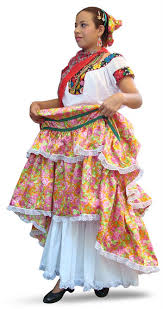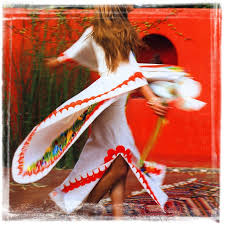source(google.com.pk)
Traditional Mexican Dress Biography
Today, the vast majority of Mexicans dress in a modern, "global" style. But you can still find examples of more traditional Mexican clothing in the many indigenous villages and communities across the country. The best examples of pre-Hispanic clothing are found on women, since men typically wore very little clothing before the Spanish conquest.
Indigenous women dress in several layers. The first is the huipil, a long, sleeveless cloak that resembles a loose dress. Over the cloak, an indigenous woman might wear a quechquemitl, an intricately woven and decorated poncho that was worn exclusively by noblewomen and priests during the Aztec empire [source: Textile Museum]. In many indigenous communities, women wear an ankle-length wrapped skirt held in place by a sash. The final piece of traditional clothing is the rebozo, a length of cloth that wraps around the shoulders and doubles as a coat or baby carrier.
Indigenous men adopted European-style pants and shirts shortly after the Spanish conquest and haven’t strayed much from that uniform ever since. The most unique aspects of male clothing are the serape and the sombrero. The sarape is a multipurpose wool cape that became famous during Mexico’s many wars and armed conflicts during the 19th and early 20th centuries [source: México Desconocido]. The serape functions as a saddle blanket, a sleeping bag and an overcoat in cold or rainy weather. Today, the serape comes in wonderfully ornate designs representing the indigenous roots of the wearer.
The sombrero is an essential article for life in the hot Mexican countryside. The traditional indigenous sombrero is woven from reeds and doesn't have the broad rim of the more ceremonial sombrero charro used by Mariachi. Both indigenous men and women wear leather sandals, and their simple cotton or wool clothing is often embroidered with intricate, colorful patterns that reflect the particular style of the home community. Even the thickness and color of the lines on a rebozo can indicate a person's home village.
Next, we'll talk about the traditional sounds of Mexican culture with an exploration of folk and popular music.
Traditional Mexican clothing combines native and European influences, with a particular focus on the use of textiles made locally. Particularly for the women, embroidery and woven designs were popular, and outfits were colorful and patterned.
Fabrics
Traditional dress-making in pre-Hispanic Mexico began with locally-made fabrics made from materials grown in the region, such as cotton, bark and agave, according to the website FactsAboutMexico.com. The Spanish influence brought with it fabrics that were popular among Europeans, including wool and silk.
Colors and Dyes
Until the European influences began to change traditional dress, people dyed their rough textiles with natural plant essences, notes Kwintessential. The Europeans brought their synthetic dye methods which were quickly taken up by local dress makers.
Special Occasions
Mexicans had particular outifts and styles for certain holidays and celebrations, including the "charro" suit worn for Carnival, according to FactsAboutMexico.com. The "charro" is a decorative, highly embroidered suit teamed with the most famous Mexican accessory of all: the sombrero hat.
The Sombrero
For many people the sombrero is a symbol of Hispanic Mexico. The wide-rimmed hat was designed to create a shadow over the face, protecting the wearer from the hot sun, and it was usually made of inexpensive straw.
When we observe the traditional Mexican clothing we find elements from European culture mixed with local traditions. Mexico has its own selection of favored fibers that they commonly use to make their traditional dresses. Cotton, agave, bark, wool and silk are amongst those fibers that have been used by the pre Hispanic civilizations that dwelled in the land. Wool and silk were particularly introduced by the Spanish much later.
In the good old days the Mexicans used to use elements from nature to bring color to their clothes. With the discovery of aniline dyes from Europe they gave up that practice and adopted the European dyeing technique. Traditional Mexican clothing comes in many varieties that are very easy to differentiate at a glance. Not only is the difference apparent in terms of the gender for which the clothes are made but even differences like social status and ethnic grouping are quite obvious. The native sense of style is also different from “Mestizo” clothing.
The traditional dress code for women consisted of a skirt accompanied by a tunic called huipil. They used a shoulder cape by the name of quechuemitl to cover their shoulders and a rezobo shawl to take over the head. The clothing for men bears likeliness to European style clothing. Trousers and shirts are common but with the native addition of the large blanket cape known as sarape. This attire is not complete without boots. As for the celebration dresses, you will find that the Mexicans have different costumes for special days in the year which are worn to complement the feel of the occasion.









Traditional Mexican Dress Biography
Today, the vast majority of Mexicans dress in a modern, "global" style. But you can still find examples of more traditional Mexican clothing in the many indigenous villages and communities across the country. The best examples of pre-Hispanic clothing are found on women, since men typically wore very little clothing before the Spanish conquest.
Indigenous women dress in several layers. The first is the huipil, a long, sleeveless cloak that resembles a loose dress. Over the cloak, an indigenous woman might wear a quechquemitl, an intricately woven and decorated poncho that was worn exclusively by noblewomen and priests during the Aztec empire [source: Textile Museum]. In many indigenous communities, women wear an ankle-length wrapped skirt held in place by a sash. The final piece of traditional clothing is the rebozo, a length of cloth that wraps around the shoulders and doubles as a coat or baby carrier.
Indigenous men adopted European-style pants and shirts shortly after the Spanish conquest and haven’t strayed much from that uniform ever since. The most unique aspects of male clothing are the serape and the sombrero. The sarape is a multipurpose wool cape that became famous during Mexico’s many wars and armed conflicts during the 19th and early 20th centuries [source: México Desconocido]. The serape functions as a saddle blanket, a sleeping bag and an overcoat in cold or rainy weather. Today, the serape comes in wonderfully ornate designs representing the indigenous roots of the wearer.
The sombrero is an essential article for life in the hot Mexican countryside. The traditional indigenous sombrero is woven from reeds and doesn't have the broad rim of the more ceremonial sombrero charro used by Mariachi. Both indigenous men and women wear leather sandals, and their simple cotton or wool clothing is often embroidered with intricate, colorful patterns that reflect the particular style of the home community. Even the thickness and color of the lines on a rebozo can indicate a person's home village.
Next, we'll talk about the traditional sounds of Mexican culture with an exploration of folk and popular music.
Traditional Mexican clothing combines native and European influences, with a particular focus on the use of textiles made locally. Particularly for the women, embroidery and woven designs were popular, and outfits were colorful and patterned.
Fabrics
Traditional dress-making in pre-Hispanic Mexico began with locally-made fabrics made from materials grown in the region, such as cotton, bark and agave, according to the website FactsAboutMexico.com. The Spanish influence brought with it fabrics that were popular among Europeans, including wool and silk.
Colors and Dyes
Until the European influences began to change traditional dress, people dyed their rough textiles with natural plant essences, notes Kwintessential. The Europeans brought their synthetic dye methods which were quickly taken up by local dress makers.
Special Occasions
Mexicans had particular outifts and styles for certain holidays and celebrations, including the "charro" suit worn for Carnival, according to FactsAboutMexico.com. The "charro" is a decorative, highly embroidered suit teamed with the most famous Mexican accessory of all: the sombrero hat.
The Sombrero
For many people the sombrero is a symbol of Hispanic Mexico. The wide-rimmed hat was designed to create a shadow over the face, protecting the wearer from the hot sun, and it was usually made of inexpensive straw.
When we observe the traditional Mexican clothing we find elements from European culture mixed with local traditions. Mexico has its own selection of favored fibers that they commonly use to make their traditional dresses. Cotton, agave, bark, wool and silk are amongst those fibers that have been used by the pre Hispanic civilizations that dwelled in the land. Wool and silk were particularly introduced by the Spanish much later.
In the good old days the Mexicans used to use elements from nature to bring color to their clothes. With the discovery of aniline dyes from Europe they gave up that practice and adopted the European dyeing technique. Traditional Mexican clothing comes in many varieties that are very easy to differentiate at a glance. Not only is the difference apparent in terms of the gender for which the clothes are made but even differences like social status and ethnic grouping are quite obvious. The native sense of style is also different from “Mestizo” clothing.
The traditional dress code for women consisted of a skirt accompanied by a tunic called huipil. They used a shoulder cape by the name of quechuemitl to cover their shoulders and a rezobo shawl to take over the head. The clothing for men bears likeliness to European style clothing. Trousers and shirts are common but with the native addition of the large blanket cape known as sarape. This attire is not complete without boots. As for the celebration dresses, you will find that the Mexicans have different costumes for special days in the year which are worn to complement the feel of the occasion.
Traditional Mexican Dress

Traditional Mexican Dress
Traditional Mexican Dress
Traditional Mexican Dress
Traditional Mexican Dress

Traditional Mexican Dress
Traditional Mexican Dress

Traditional Mexican Dress
Traditional Mexican Dress

Traditional Mexican Dress
 Traditional Mexican Dress
Traditional Mexican Dress
No comments:
Post a Comment